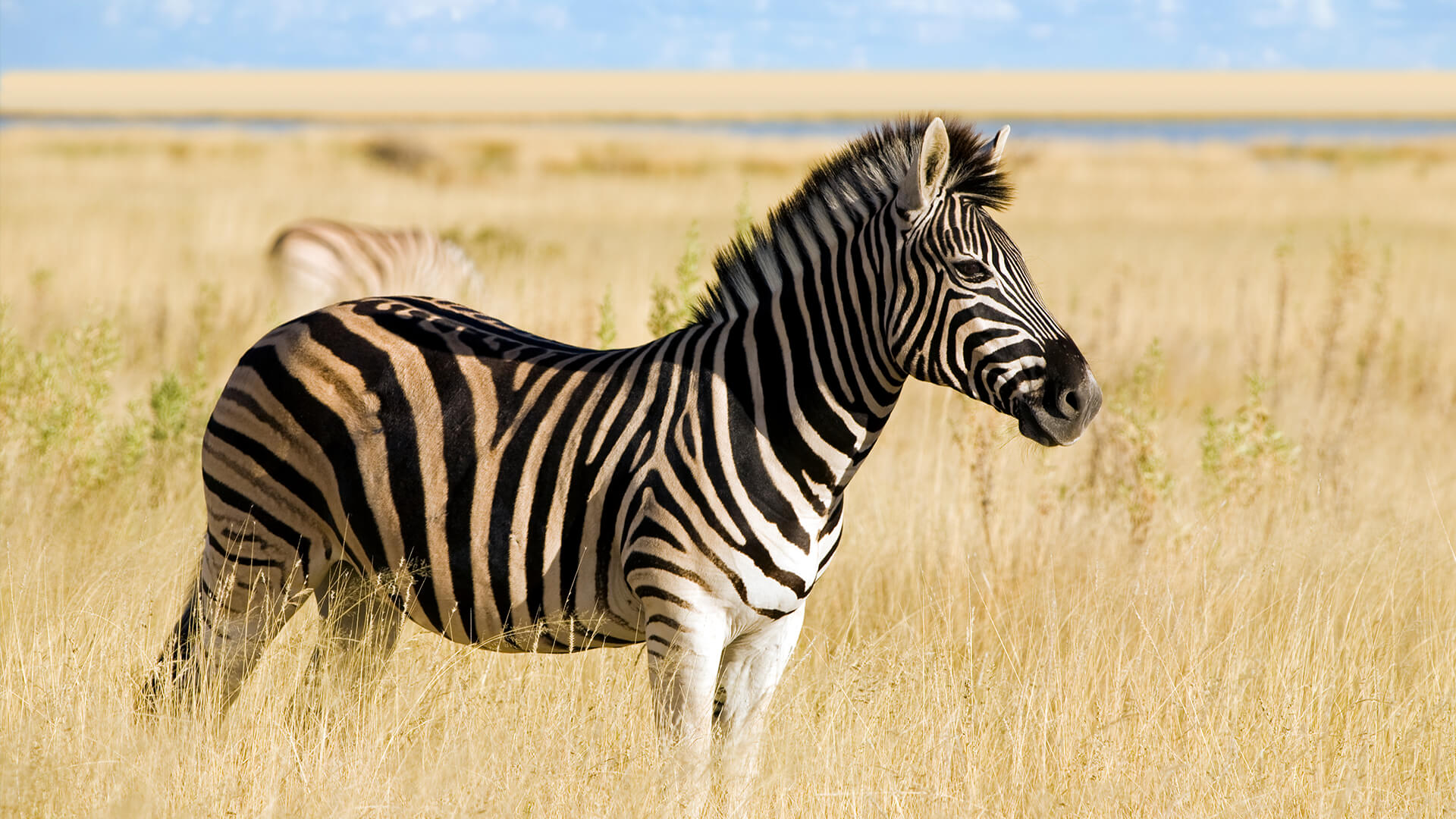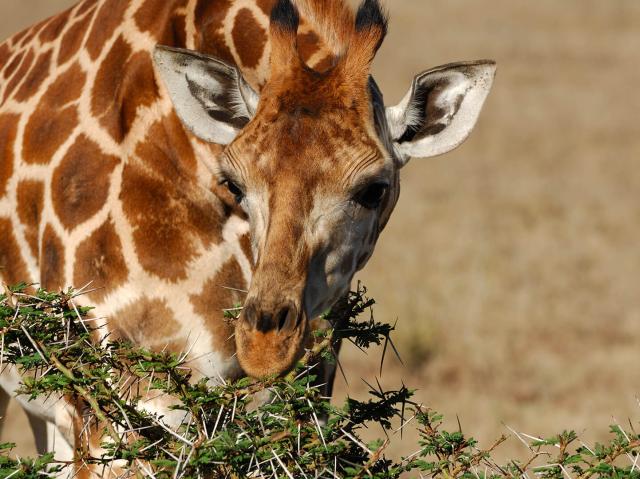
Zebra

- CLASS: Mammalia (Mammals)
- ORDER: Perissodactyla
- FAMILY: Equidae
- GENUS: Equus
- SPECIES: zebra (mountain zebra), quagga (plains zebra), grevyi (Grevy’s zebra)
- SUBSPECIES: 7

ABOUT
Zebras are sturdy, spirited individuals that offer a study in contrasts beyond their black and white stripes. They're willful and playful, social and standoffish, resilient and vulnerable. For some, life in a herd can be complex, yet they also find safety in numbers. They are prey for predators, but they're also quite capable defenders.
Zebras are equids, members of the horse family. They have excellent hearing and eyesight and can run more than 40 miles per hour (64 kilometers per hour). They also have a powerful kick that can cause serious injury to a predator, like a lion, a hyena, or an African wild dog. Usually the lead male of the herd, called a stallion, sounds the alarm if danger is spotted and stays at the back of the group to defend against predators if necessary, while mares (females) and foals (young) run away.
Zebras often trot when moving to new pastures, which is a fairly fast but easy gait for them to use over the long distances they may have to travel. Their hard hooves are designed to withstand the impact of their body weight and to run easily over rocky ground. When resting at night, zebras lie down while one stands watch to prevent an ambush.
Stripes: White with black or black with white? This is one of the most popular questions about zebras. Zebras are generally thought to have white coats with black (or sometimes brown) stripes. That's because if you look at most zebras, their stripes end on their belly and toward the inside of their legs, and the rest of their body is all white. However, some zebras are born with genetic variations that make them all black with white stripes, or mostly dark with a striped pattern on just part of their coats. And as it turns out, zebras have black skin underneath their hair. So it depends on how you look at it!
A zebra's stripes serve as a form of protection from predators. When zebras gather together, their overlapping stripes make it hard for a lion or leopard to pick out one zebra to chase. Zebra stripes are unique to each individual—a fact that helps researchers identify individual zebras.
At first it might seem like a zebra is a zebra, but there are three different species: plains, mountain, and Grevy’s zebras. Different zebra species have different types of stripes, from narrow to wide. In fact, the farther south on the African plains you travel, the farther apart the stripes on zebras get! All zebras have the same basic body type, however—a large head, sturdy neck, long legs, a dorsal stripe along the spine and down a tasseled tail, and a bristly mane. No zebra, or other wild equid, has a forelock.
Grevy’s zebras are the largest, weighing from 770 to 990 pounds (350 to 450 kilograms) and measuring up to 5 feet (1.5 meters) at the shoulder. Their thick necks and large, round ears give them the most mule-like physique. Grevy’s zebras also have the thinnest stripes, extending all the way down to their white belly. On their hindquarters, the stripes are vertical until above their hind legs.
Mountain zebras have vertical stripes on their neck and torso, which graduate to wider—and fewer—horizontal stripes on their haunches. They have a gridiron pattern on their rump, and their white underside has a dark stripe that runs the length of their belly. Mountain zebras also have a distinctive dewlap on their throat that looks a bit like an Adam’s apple.
Plains zebras are the most abundant and the smallest of the three zebra species. Some subspecies have a stripe pattern different from all others: brownish “shadow” stripes between the black stripes on their coat.
HABITAT AND DIET
Different zebras have different habitats: Grevy’s zebras live in semi-arid grassland habitat in Kenya, Ethiopia, and Somalia. Mountain zebras, as their name implies, inhabit rocky, arid slopes in Namibia and Angola. Plains zebras, which are the most abundant of the three zebra species, are found from the grasslands of East Africa to the scrubby woodlands of southern Africa. They are one of Africa’s most successful and adaptable large herbivores. A subspecies of plains zebras, Grant’s zebras, are famous for their spectacular migrations during the rainy season in the Serengeti, when as many as 10,000 individuals journey together in congregated herds.
Zebras are herbivores and feed mostly by grazing on grasses, although they also might browse a bit on the leaves and stems of bushes. They graze for many hours each day, using their strong front teeth to clip off the tips of grass.
As the dry season arrives and grasses die back, zebra herds travel to find more food and water holes for drinking. Most zebras are considered nomadic, without specific territories. The exception is with Grevy's zebras. Stallions of this species mark out territories with urine and dung. Mares, their foals, and immature males wander through as they wish. If food becomes scarce, though, stallions leave their territories for a while and travel with the larger herds.
Zebras at the San Diego Zoo and the San Diego Zoo Safari Park eat grass hay.
FAMILY LIFE
Plains and mountain zebras are social herd animals, living in family groups with a stallion, several mares, and their offspring. During certain times of the year, these groups gather together to form loosely associated herds of up to several hundred, but family groups still stay together within these larger groups. Grevy’s zebras do not have a herd system, and males and females have no permanent bonds. Grevy’s zebra stallions establish territories, with mares crossing through them to breed and foal. Once foals are old enough to travel, mares usually leave the protection of the stallion’s territory to continue their nomadic lifestyle.
Zebras communicate with one another with facial expressions and sounds. They make loud braying or barking sounds and soft snorts and whuffs. The position of their ears, how wide open their eyes are, and whether their mouths are open or their teeth are bared all mean something. Ears flat back, for example, means trouble, or you better follow orders! Zebras also reinforce their bonds by grooming each other. You might see two zebras standing head to back, apparently biting each other, but they are really only nibbling on each other with their teeth to pull out loose hair and get a good scratch.
Similar to domestic horses, zebras put a good deal of energy into raising their offspring. Zebra foals have soft, fuzzy fur, and their stripes are usually brown and white at first. Their legs are already almost as long as an adult zebra’s and they can walk just 20 minutes after birth and can run after an hour! This is important, since mares need to move with the herd to find food and water. She cannot leave her foal behind, so it must be up and running quickly in order to stay with the family.
Foals must recognize their mother from birth to survive. A foal learns its mother’s stripe pattern to stay close to her. Mares usually do not adopt other foals, so there would be no chance of getting food from anyone but Mom. Mothers often separate from the herd a short distance so that their foals can imprint on them. Once a foal can readily identify its mother, the mare and her foal return to the herd for protection.
CONSERVATION
There are some threats—habitat loss, poaching, and disease—that zebras can’t outrun. With a wild population of about 35,000, mountain zebras are classified as Threatened. Cape mountain zebras came very close to extinction as a result of hunting and competition with domestic cattle. In 1937, Mountain Zebra National Park was established in South Africa, where only 47 Cape mountain zebras remained. Their numbers have now increased to a few thousand, with the majority still in the national park.
The endangered Grevy’s zebra population has been ravaged by disease outbreaks, dropping its ranks to an estimated wild population of less than 2,000 mature individuals. San Diego Zoo Wildlife Alliance is a member of the Grevy’s Zebra Trust, an independent wildlife conservation organization in Kenya. Our scientists are collaborating with conservation partners in our Savanna Conservation Hub to help conserve Grevy's zebras in their native habitats.
By joining San Diego Zoo Wildlife Alliance as an ally for wildlife, you help save species worldwide.
Sounds
LIFE SPAN
12-17 years on average, depending on the species
YOUNG
Gestation: 12 to 14 months
Number of young at birth: 1
Weight at birth: 55 to 88 pounds (25 to 40 kilograms)
Age of maturity: 1 to 6 years, depending on the sex and species
SIZE
Height: 4.2 to 5 feet (1.3 to 1.5 meters) tall
Weight: 480 to 990 pounds (218 to 450 kilograms)
FUN FACTS
Each zebra has a unique stripe pattern—no two are alike.
A zebra's eyesight at night is thought to be about as good as that of an owl.
Zebras have a pad of fat under their mane that helps it stand upright.










